Your companion after the operation
You have successfully survived the cruciate ligament reconstruction. But what happens next? When can you shower again? How much weight can be put on the knee? Who will give the antithrombosis injection? Questions upon questions. This treatment schedule is intended to provide postoperative assistance as well as detailed guidance and instructions. The prescribed chronological sequence of the individual therapeutic measures is based on our many years of experience and the guidelines developed from it. The aim is to achieve a customized, individual rehabilitation as a basis for further optimal healing success after the operation.
Treatment calendar anterior cruciate ligament reconstruction
(uncomplicated isolated cruciate ligament rupture)
The contents in the aftercare following anterior cruciate ligament reconstruction are treatment recommendations based on our many years of experience in the treatment of this injury. Deviations from the recommended values are possible at any time, or necessary if medically indicated.
Mobility
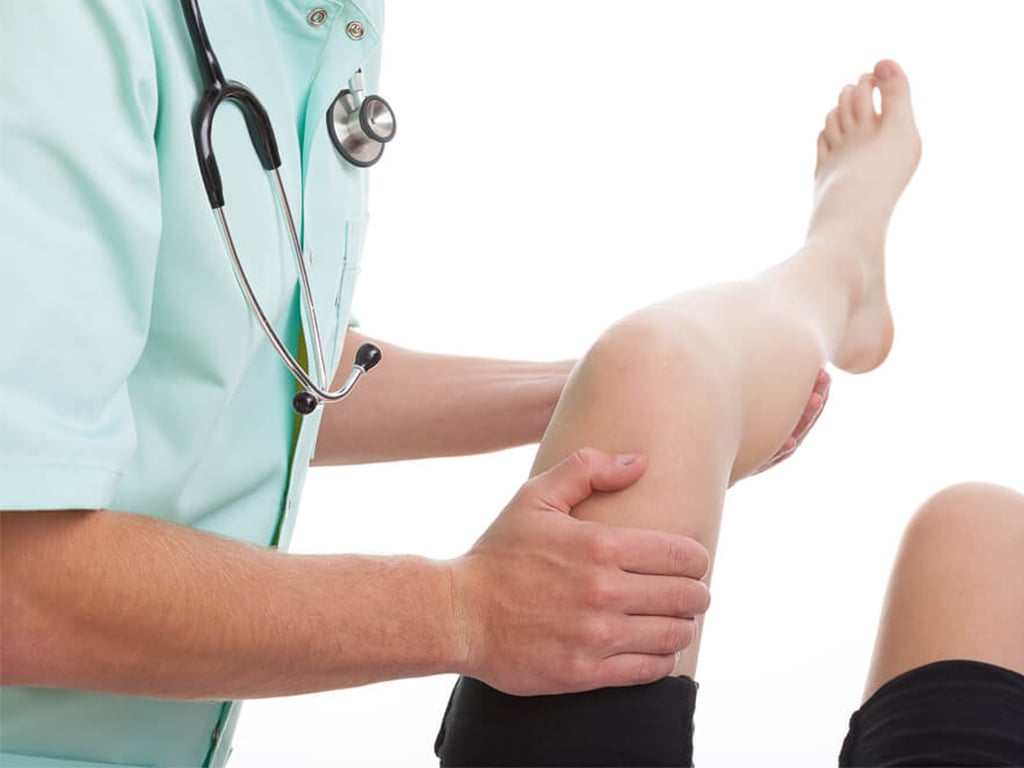
- Mobility of the knee joint: free - no movement restrictions in flexion and extension, i.e. the knee joint can be moved freely without limitation, as far as this is possible after the operation.
- Therapy goals Physiotherapy: Pain relief/reduction - Reduction of swelling and knee joint effusion - Preservation of mobility of the femuropatellar joint
- Range of motion of the knee joint: ROM (range of motion or neutral zero method): free - no movement restrictions in flexion and extension, i.e. the knee joint can be moved freely without limitation as far as this is possible after the operation.
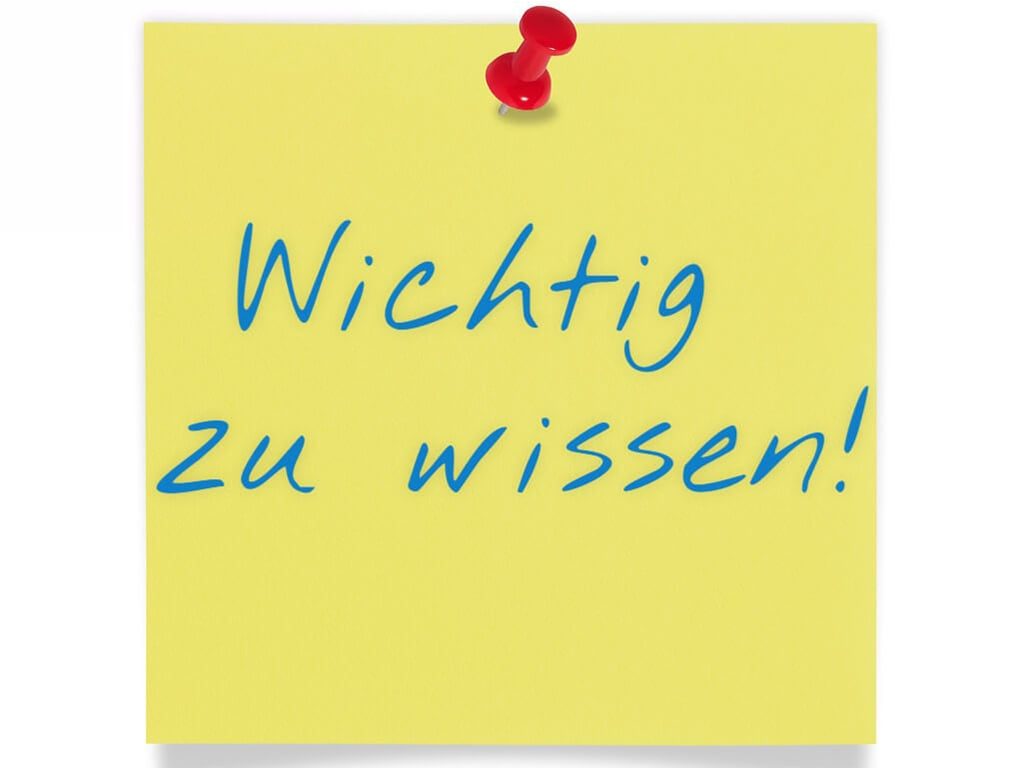
What is ROM ? (range of motion or determination of mobility by the neutral zero method): is a standardised orthopaedic assessment and documentation index for the mobility of joints. It is expressed as a code that represents the range of motion of a joint in angular degrees about a given axis. In this way, mobility is clearly traceable and documentable in findings and letters.
- Therapy goals Physiotherapy: Pain relief/reduction - Reduction of swelling and knee joint effusion - Preservation of mobility of the femuropatellar joint
- Medical check-up: at the Freiburg OZ or at your orthopaedist's office for follow-up treatment.
- CPM splint : (Motor movement splint)- The prescription of the CPM splint is optional, depending on the severity of the condition.
Adjustment of mobility ROM extension/ flexion: 0-0-60 degrees possible !
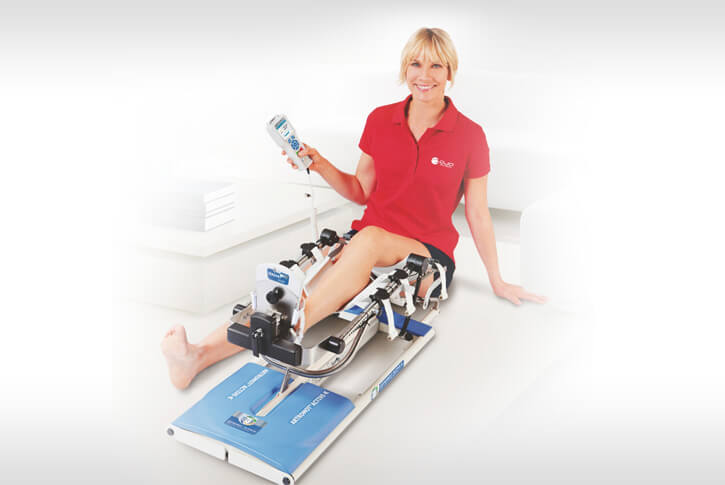
- Own exercises: You start with tension exercises (quadriceps activation) for the thigh muscle. These first isometric exercises contain parts of coordination training. They are characterised by repetitive muscle contractions without changing the length of the muscle.
→ WATCH VIDEO - Physiotherapy: 1st appointment with her therapist. Focus: Lymphatic drainage, walking school, improvement of extension and treatment of the iliopsoas muscle.
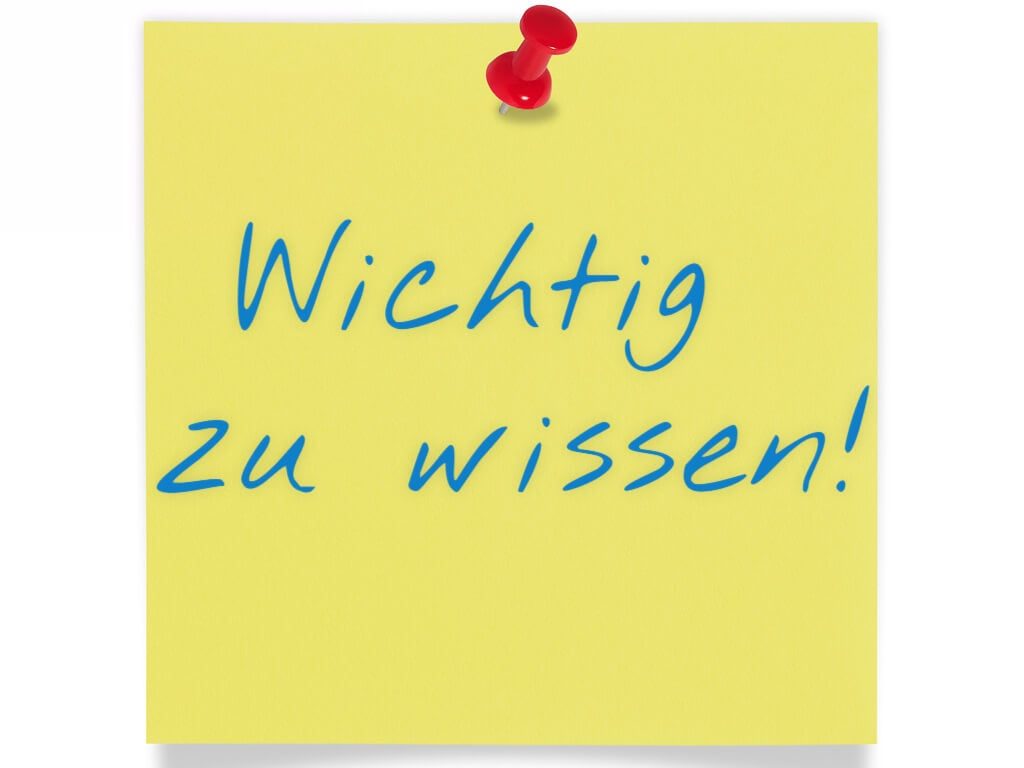
The iliopsoas muscle is the strongest flexor of the hip joint. It is also involved in raising the trunk from the supine position, as this is done by flexion in the hip joint. It is prone to considerable tension due to compensatory overload caused by the failure of the quadriceps in the context of an injury or after an operation on the knee joint. physiotherapist into the treatment regime after surgery!
→ WATCH VIDEO
- Mobility of the knee joint: free - no movement restrictions in flexion and extension, i.e. the knee joint can be moved freely without limitation, as far as this is possible after the operation.
- Therapy goals Physiotherapy: Pain relief/reduction - Reduction of swelling and knee joint effusion - Preservation of mobility of the femuropatellar joint
- CPM splint: (motorised movement splint)-adjustment of ROM stretching/bending mobility: 0-0-90 degrees possible !

- Own exercises: They continue their tensioning exercises (quadriceps activation) for the thigh muscle. These first isometric exercises include parts of coordination training. They are characterised by repetitive muscle contractions without changing the length of the muscle.
- Physiotherapy focus: lymphatic drainage, walking school, improvement of extension, muscular and neuromuscular coordination and treatment of the iliopsoas muscle.
The iliopsoas muscle is the strongest flexor of the hip joint. It is also involved in raising the trunk from the supine position, as this is done by flexion in the hip joint. It is prone to considerable tension due to compensatory overload caused by the failure of the quadriceps in the context of an injury or after knee joint surgery and should be included in the treatment regimeby your physiotherapist after surgery!
→ WATCH VIDEO
- Mobility of the knee joint: free - no restriction of movement in flexion and extension, i.e. the knee joint can be moved freely without limitation.
- Therapy goals Physiotherapy: Pain relief/reduction - Reduction of swelling and knee joint effusion - Preservation of mobility of the femuropatellar joint
- CPM splint: (motorised movement splint)-adjustment of ROM stretching/bending mobility: 0-0-90 degrees possible !

- Own exercises: They continue their tensioning exercises (quadriceps activation) for the thigh muscle. These first isometric exercises include parts of coordination training. They are characterised by repetitive muscle contractions without changing the length of the muscle.
- Physiotherapy focus: lymphatic drainage, walking school, improvement of extension, muscular and neuromuscular coordination and treatment of the iliopsoas muscle.
The iliopsoas muscle is the strongest flexor of the hip joint. It is also involved in raising the trunk from the supine position, as this is done by flexion in the hip joint. It is prone to considerable tension due to compensatory overload caused by the failure of the quadriceps in the context of an injury or after knee joint surgery and should be included in the treatment regime by your physiotherapist after surgery!
→ WATCH VIDEO
- Mobility of the knee joint: free - no restriction of movement in flexion and extension, i.e. the knee joint can be moved freely without limitation.
- Therapy goals Physiotherapy: Normalisation of mobility - Progressive increase in load until full load is achieved - Restoration of coordinative abilities - Stabilisation of the physiological pelvic-leg axis
- CPM track: (motorised movement track)-adjustment of mobility ROM extension/ flexion: free-no limitation

- Own exercises: They continue their tensioning exercises (quadriceps activation) for the thigh muscle.
- Physiotherapy focus: lymphatic drainage, walking school, improvement of stretching, muscular and neuromuscular coordination and treatment of the iliopsoas muscle
Medical check-up at the OZ Freiburg: One month after surgery
- Mobility of the knee joint: free - no restriction of movement in flexion and extension, i.e. the knee joint can be moved freely without limitation.
- Therapy goals Physiotherapy: Normalisation of mobility - Progressive increase in load until full load is achieved - Restoration of coordinative abilities - Stabilisation of the physiological pelvic-leg axis
- Own exercises: They continue their tensioning exercises (quadriceps activation) for the thigh muscle and do not forget their physiotherapy appointment.
- Quadriceps activation: self exercise phase 1
Examination findings 4 weeks after anterior cruciate ligament reconstruction:

Ideally, the following findings should be present:
- No pain at rest and under stress
- Irritation-free joint without significant effusion formation
- No or only slight swelling of the capsule
- Free mobility in extension, flexion usually not yet fully feasible
- full band stability
- No significant muscle shortening (rectus femoris, iliopsoas, hamstring muscles) in lateral comparison!
- Good displaceability of the patella
- Beginning neuromuscular and muscular functional stabilisation, especially quadriceps muscle, hip abductors and muscles for external rotation of the hip!
- Mobility of the knee joint: free - no restriction of movement in flexion and extension, i.e. the knee joint can be moved freely without limitation.
- Therapy goals Physiotherapy: Normalisation of mobility - Progressive increase in load until full load is achieved - Restoration of coordinative abilities - Stabilisation of the physiological pelvic-leg axis
- Own exercises: You continue the tensioning exercises (quadriceps activation) for the thigh muscle. These first isometric exercises include parts of coordination training. They are characterised by repetitive muscle contractions without changing the length of the muscle. Quadriceps activation: self exercise
- Intensification of physiotherapeutic measures.
- Therapy goals Physiotherapy: Normalisation of everyday motor skills - Achievement of physiological muscle balance of the entire pelvic-leg axis
- Special rehabilitation measures: now possible, required for competitive athletes !

Important build-up training in the late phase of rehabilitation before the start of sport-specific exercise :
- Training of "knee-saving" landing techniques
By loading the video, you agree to YouTube's privacy policy.
Learn more - Trunk stability training or core training
- Training of the hip abductors and especially external hip rotators
- Strengthening the rear thigh muscles, e.g. hamstring muscles
- Exercises to improve "two-footedness" in football
- Leg axis training
Load
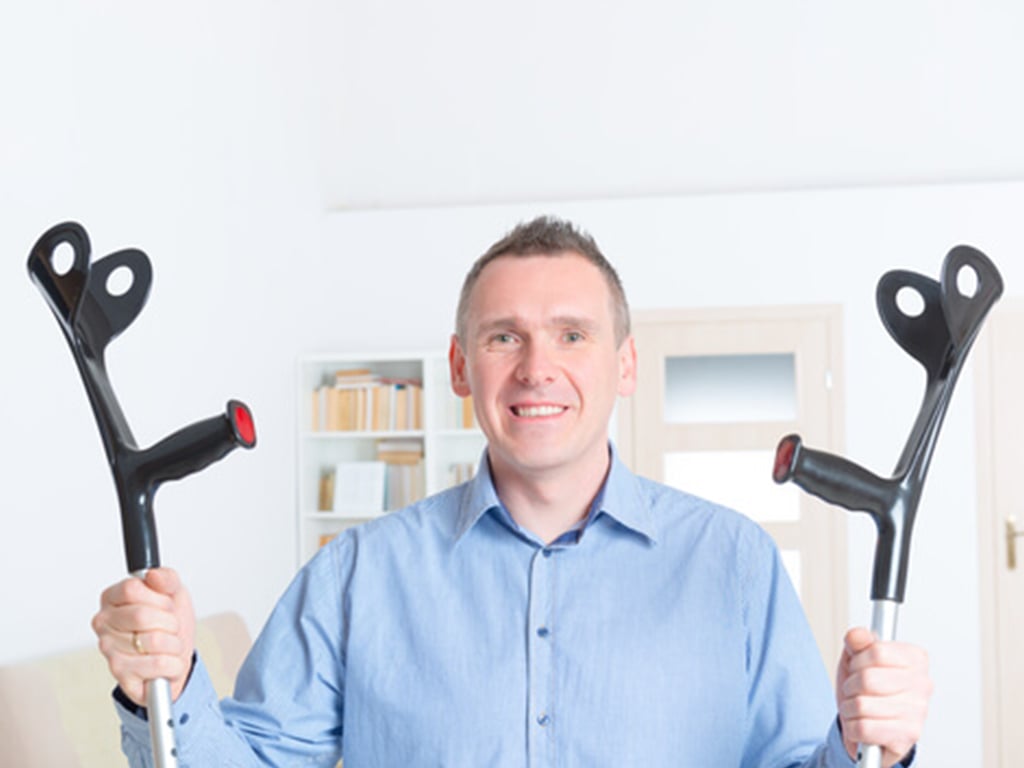
- Walking with two crutches: due to the nerve blockade (reduction of pain) after ACL surgery, full relief of the operated leg is necessary on the day of the operation - no weight-bearing on the operated leg!
- Adjustment of the crutches: In order to be able to walk reasonably with walking sticks, the length of these walking aids must also be the right one, i.e. the correct length must first be determined. The correct and suitable length is decisive in order to be able to use the walking sticks safely and stably. This depends, among other things, on the height of the user. If the walking sticks are too short, one must always bend slightly forward to support oneself. If the length is too high, it is more difficult to keep your balance.
Walking with forearm crutches with partial weight-bearing- Three point gait-
- Walking with two crutches: with up to 20 kg partial load. Rolling of the foot with sole contact.

Stand on a scale at home, first with the healthy leg, then with the operated leg, to "feel" what load about 20 kg requires!
- Walking with two crutches: increasing load possible up to half body weight. half the body weight.
Full loading is possible if:
- there isno significant swelling with effusion formation in the knee joint
- there is no significant increase in pain with an increase in load
- none Pain medication must be taken
 Full weight bearing initially only in the home environment for short distances (still possible with both walking sticks at the beginning), no hikes or longer walks.!
Full weight bearing initially only in the home environment for short distances (still possible with both walking sticks at the beginning), no hikes or longer walks.!
Full loading is possible if:
- there isno significant swelling with effusion formation in the knee joint
- there is no significant increase in pain with an increase in load
- none Pain medication must be taken
 Full load also possible for longer distances, no hiking or longer walks!
Full load also possible for longer distances, no hiking or longer walks!
- Medical check-up at the OZ Freiburg: One month after surgery
- Full load: also permitted for longer distances if the knee joint does not react to increasing load with pain or effusion!
- Full load: mostly possible without restrictions
- Full load: allowed without restrictions !
Medicines
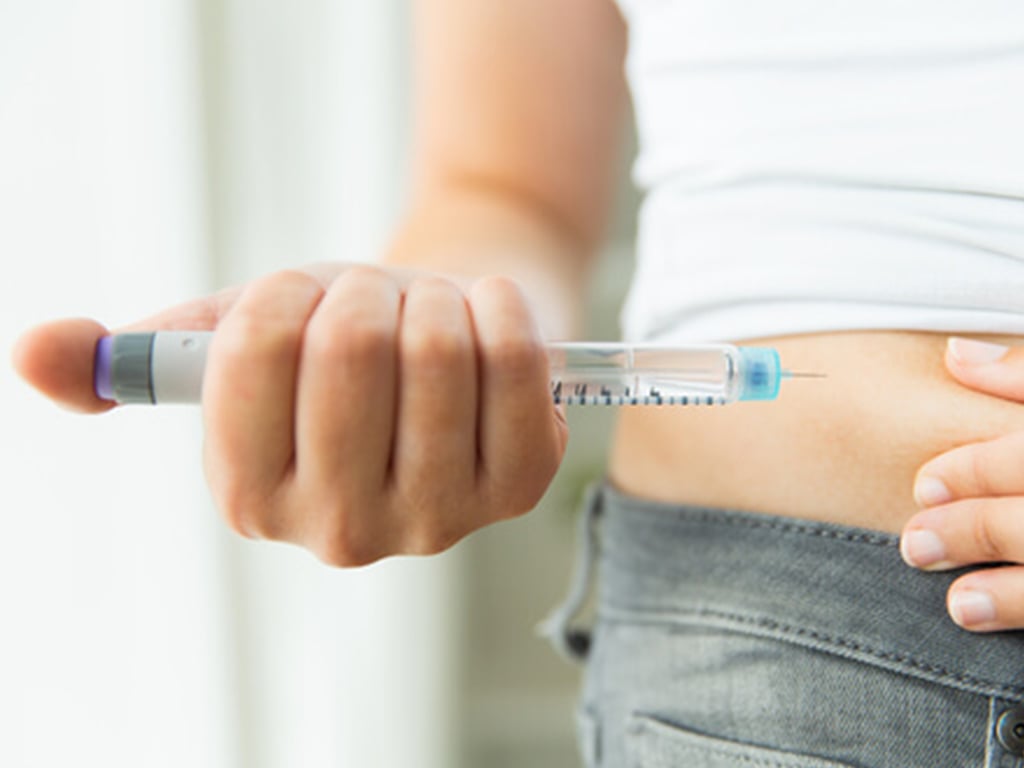
- The antithrombosis injection: they have already received it in the clinic! Here we show them how to inject themselves with their heparin syringe:
Injection instructions for the use of a heparin safety syringe for self-injection:
- Pain medication: Take according to doctor's prescription!
- Blood thinners: If you have already taken blood thinning medication (anticoagulants), such as Marcumar or Xarelto, or ASS (Aspirin), before the operation, close consultation with the surgeon, general practitioner and anaesthetist is required before the operation!
- Theantithrombosis injection: you will receive it today from us or from your treating doctor during the check-up!
- Pain medication: can be continued or reduced as needed depending on pain intensity.
- Blood thinners: If you have already taken blood thinning medication (anticoagulants), such as Marcumar or Xarelto, or ASS (Aspirin), before the operation, close consultation with the surgeon, general practitioner and anaesthetist is required before the operation!
- You must continue to "administer" theantithrombosis injection yourself until you are fully loaded! Here we show you how to administer it yourself:
Injection instructions for the use of a heparin safety syringe for self-injection:
- Pain medication: can be reduced or no longer taken, depending on the intensity of the pain!
- Blood thinners: If you have already taken blood thinning medication (anticoagulants), such as Marcumar or Xarelto, or ASS (Aspirin), before the operation, close consultation with the surgeon, general practitioner and anaesthetist is required before the operation !
Theantithrombosis injection: can be discontinued when normal walking under full weight bearing is possible and no risk factors are present!
Pain medication: is often no longer necessary during this treatment period
Risk factors: Risk of thrombosis!

If risk factors are present, e.g. family history of thrombosis or if you have had thrombosis in the past, urgent consultation with us or your attending physician is required! → In this case, continue the antithrombosis injections until clarification by the surgeon or the doctor providing follow-up treatment!
- Theantithrombosis injection: can now be discontinued if normal walking under full load is possible and no risk factors are present!
- Pain medication: is often no longer necessary at this stage of treatment
- Risk factors: Risk of thrombosis!

If risk factors are present, e.g. family history of thrombosis or if you have had thrombosis in the past, urgent consultation with us or your attending physician is required! → In this case, continue until clarification by the surgeon or the doctor providing follow-up treatment!
- Theantithrombosis injection: discontinued!
- Pain medication: discontinued!
- Theantithrombosis injection: discontinued!
- Pain medication: discontinued!
- Theantithrombosis injection: discontinued!
- Pain medication: discontinued!
Orthosis
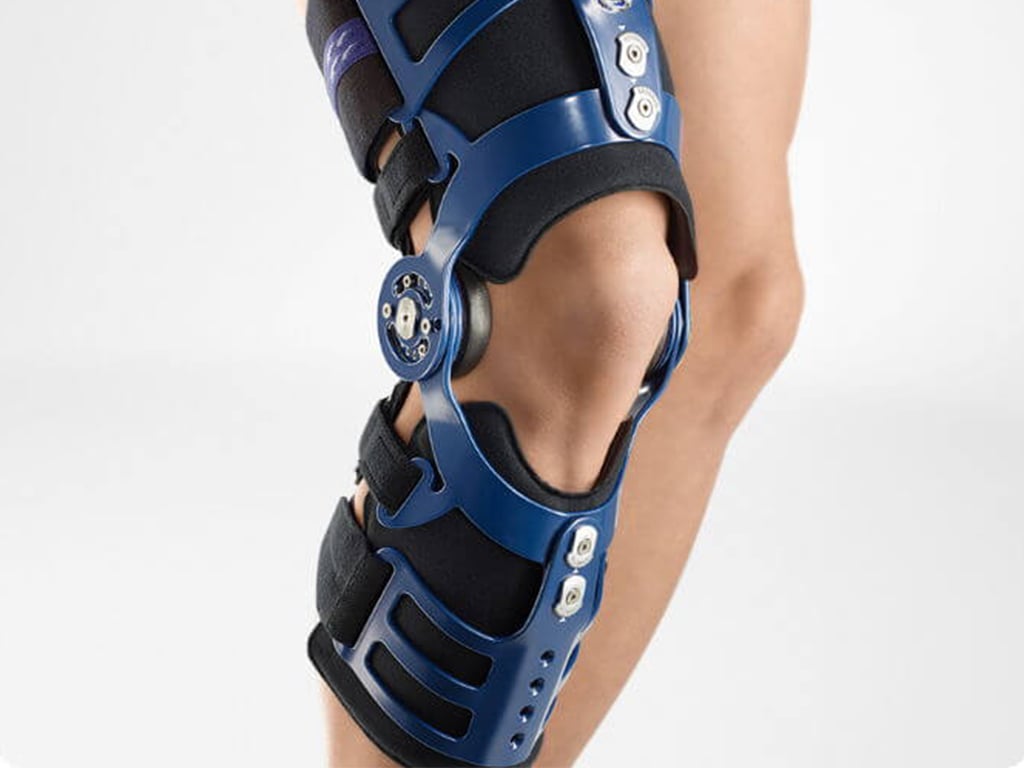
- Orthosis (splint fitting): is not required! Optional for certain anatomical conditions.
- Orthosis (splint fitting): is not required! Optional for certain anatomical conditions.
- Orthosis (splint fitting): is not required! Optional for certain anatomical conditions.
- Orthosis (splint fitting): is not required! Optional for certain anatomical conditions.
- Orthosis (splint fitting): not required!
- Orthosis (splint fitting): not required!
- Orthosis (splint fitting): not required!
- Orthosis (splint fitting): not required!
Important
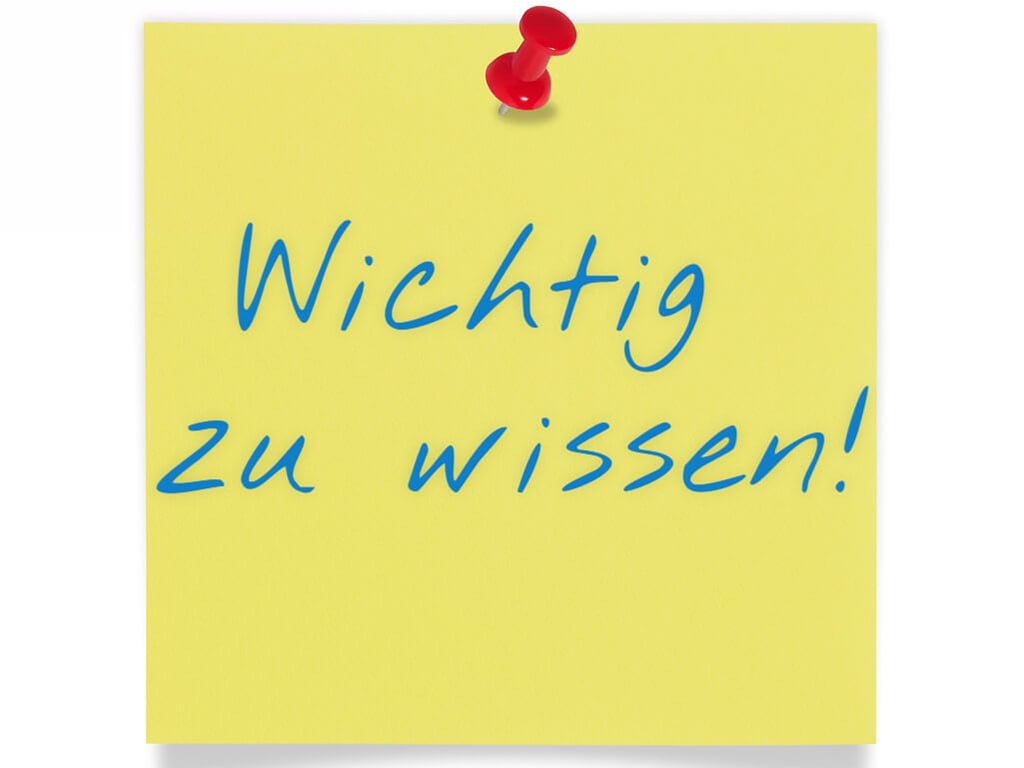
They were successfully operated on the cruciate ligament and are now either back at home or in hospital as inpatients.
inpatients: If they are treated as inpatients after an operation, everything is taken care of. The nursing staff is there for them 24 hours a day, regular medical visits ensure a complication-free healing process.
outpatients : If they continue to be treated as outpatients after an operation, the following should be taken into account:
- Cooling: Keep ice packs (Cool Packs) ready to put on the bandage! (20 min./hour)
- Drainage: If you have received drains (Redon drainage) after the operation to drain blood and fluid from wound or joint cavities by means of suction, leave them untouched. It is usually removed the next day (1st day after the operation) by us or your orthopaedic surgeon.
- Contacting us: In the case of an outpatient operation, our team will contact you by telephone after you have returned to your home environment.

Please inform us of your availability by telephone on the day of the operation during the consultation!
Inpatients: The medical visit takes place in the clinic with wound control, dressing change, possibly removal of the drainage.
outpatients:
- Medical check-up: at the Freiburg OZ or at your orthopaedist's office for follow-up treatment.
- Dressing change: Removal of drains (Redon drainage).
- Ice pack: Continue to use ice packs or cool packs (20 min/hour).
- Physiotherapy: Continuation with focus on lymphatic drainage and walking school
- Ice pack: Continue to use ice packs or cool packs (20 min/hour).
- Antithrombosis syringe: please do not forget!
- Showering: as of today, showering is possible and allowed! Advantageous is the use of a shower plaster
Exception:

Due to effusion formation with development of pain and restriction of movement, a puncture of the joint was performed after the operation. Then there should be one day between puncture and showering.
- Bath applications/sauna: Baths and sauna of any kind are prohibited
- Ointment dressings: Ointment dressings and applications of any kind are prohibited, e.g. no ointments containing cortisone!
- Medical check-up at the OZ Freiburg: for wound control, suture removal and X-ray documentation.
- Showers: Showering possible and allowed! Advantageous, but not absolutely necessary, is the use of a shower plaster
- Work incapacity: Depending on the occupational activity, work incapacity may be possible, e.g. in the case of more sedentary activities, irritation-free knee joint findings and increasingly free mobility.
- Driving a car: possible to a limited extent if they no longer need walking sticks, can bear full weight, have full extension with a bend of up to 90 degrees and no longer need pain medication!
- Showers: Showering possible and allowed! Advantageous, but not absolutely necessary, is the use of a shower plaster
- Work incapacity: Depending on the occupational activity, work incapacity is possible, e.g. in the case of more sedentary activities, irritation-free knee joint findings and increasingly free mobility.
- Driving a car: possible to a limited extent if they no longer need walking sticks, can bear full weight, have full extension with a bend of up to 90 degrees and no longer need pain medication!
- Medical check-up at the OZ Freiburg: Don't forget your check-up! Four weeks after the operation, you will have to decide whether you can increase your exertion beyond the everyday stresses!
- Bathing/sauna: Baths and saunas of any kind are now possible if the wound is completely closed and the knee is not irritated, e.g. there is no irritation.
- Ointment dressings: Ointment dressings and applications are now possible when there is complete wound closure (please let us know which ointment you would like to use). Ointments to prevent excess scarring (e.g. Contractubex) can be used.
- Ability to work: possible for occupational sedentary work. Longer walking distances are not yet possible! Heavy physical activities are not yet possible
- Ability to work: possible for occupational sedentary work. Longer walking distances are not yet possible! Heavy physical activities are not yet possible
- Special rehabilitation measures: now possible, required for competitive athletes !

Important build-up training in the late phase of rehabilitation before the start of sport-specific exercise:
- Training of "knee-saving" landing techniques
By loading the video, you agree to YouTube's privacy policy.
Learn more - Trunk stability training or core training
- Training of the hip abductors and especially external hip rotators
- Strengthening the posterior thigh muscles, e.g. hamstring muscles
- Exercises to improve "two-footedness" in football
- Leg axis training

